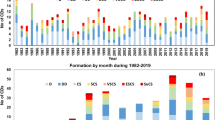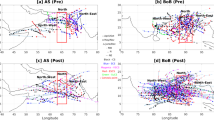Abstract
Tropical Cyclones (TCs) have devastating effects on several coastal regions worldwide. Accurate estimation of TC characteristics such as wind direction, wind speed, eye, rainfall bands, and radius of maximum wind helps to understand the evolution of TCs throughout their life cycle and plays an essential role in mitigating TC impact. Existing literature has focused on TC wind direction, intensity, cloud shape, and eye, but there has been limited research on the estimation of the Radius of Maximum Wind (RMW). An accurate estimate of RMW helps in identifying the regions where TC’s strongest wind and most intense cooling of the ocean occur. In this study, our objective is to formulate a method to determine the value of the RMW over the North Indian Ocean (NIO), this region has been chosen as it has the Bay of Bengal and the Arabian Sea which are one of the six globally prominent areas prone to TCs. Our study is on the relationship between the center of the TC, the estimated pressure drop at the center, and the RMW, using historical observations and mathematical correlations. We validate the accuracy of our developed method using three statistical measures: error percentage, t-test, and root mean square error. Our findings indicate that our method exhibits a mean absolute error percentage ranging from approximately \(6\%\) to \(32\%\), whereas the formulation of RMW from other studies has a mean absolute error range of \(13\%\) to \(128\%\) concerning IMD best track data.








Similar content being viewed by others
Data Availability
The datasets include TC metrics such as TC number, time (year, month, day, and hour), locations (longitude and latitude of TC center), estimated central pressure (\(P_{c}\)), maximum wind speed (\(V_{m}\)), and estimated pressure drop at the center (\(P_{d}\)), which are stored in the datasets at a time interval of 3 hours is freely available on the website of Indian Meteorological Department. Python code can be provided by the corresponding author by a reasonable request.
References
Agency FEM (2012) HAZUS-MH 2.1 hurricane model technical manual. FEMA Washington, DC
Camargo SJ (2013) Global and regional aspects of tropical cyclone activity in the CMIP5 models. J Clim 26(24):9880–9902
Chavas DR, Knaff JA (2022) A simple model for predicting the tropical cyclone radius of maximum wind from outer size. Weather Forecast 37(5):563–579. https://doi.org/10.1175/WAF-D-21-0103.1
Chavas DR, Lin N, Emanuel K (2015) A model for the complete radial structure of the tropical cyclone wind field. Part I: comparison with observed structure. J Atmos Sci 72(9):3647–3662
Crunch C (2023) Disasters year in review 2022. Centre for Research on the Epidemiology of Disasters
Division CW (2021) Cyclonic storm Gulab over Bay of Bengal during 24th – 28th September 2021. India Meteorological Department
Division CW (2021) Cyclonic storm, “Jawad” (02nd – 06th December, 2021): a report. India Meteorological Department
Division CW (2021) Extremely severe cyclonic storm, “Tauktae” (14th – 19th May, 2021): a report. India Meteorological Department
Division CW (2021) Very severe cyclonic storm, “Yaas” over Bay of Bengal (23rd – 28th May, 2021): a report. India Meteorological Department
Division CW (2022) Cyclonic storm Sitrang over the Bob (22nd-25th October, 2022): a report. India Meteorological Department
Division CW (2022) Severe cyclonic storm, “Asani” (07th – 12th May, 2022): a report. India Meteorological Department
Division CW (2022) Severe cyclonic storm Mandous over the bob (6th-10th December, 2022): a report. India Meteorological Department
Emanuel K (2003) Tropical cyclones. Ann Rev Earth Planet Sci 31(1):75–104
Gross JM, DeMaria M, Knaff JA, Sampson CR (2004) A new method for determining tropical cyclone wind forecast probabilities. Preprints, 26th conf. on hurricanes and tropical meteorology, Miami, FL, amer. meteor. soc. a (vol 11)
Guha-Sapir D, Below R, Hoyois P (2019) EM-DAT. International disaster database (Brussels—Belgium: Université Catholique de Louvain). Accesed 30 Jan 2023
Gupta H, Sil S, Gangopadhyay A, Gawarkiewicz G (2023) Observed surface and subsurface marine heat waves in the bay of Bengal from in-situ and high-resolution satellite data. Clim Dyn. https://doi.org/10.1007/s00382-023-06913-5
Holland GJ (1997) The maximum potential intensity of tropical cyclones. J Atmos Sci 54(21):2519–2541
Hsu S, Yan Z (1998) A note on the radius of maximum wind for hurricanes. J Coast Res 14(2)
IMD (2021) Standard operational procedure for cyclone warning in India. India Meteorological Department
Islam T, Peterson RE (2008) Tropical cyclone wind characteristics for the Bangladesh coast using Monte Carlo simulation. J Appl Sci 8(9):1249–1255
Jangir B, Swain D, Ghose S (2021) Influence of eddies and tropical cyclone heat potential on intensity changes of tropical cyclones in the North Indian Ocean. Adv Space Res 68(2):773–786
Jangir B, Swain D, Ghose SK, Goyal R, Bhaskar TU (2020) Inter-comparison of model, satellite and in situ tropical cyclone heat potential in the North Indian Ocean. Nat Hazards 102:557–574
Khouakhi A, Villarini G, Vecchi GA (2017) Contribution of tropical cyclones to rainfall at the global scale. J Clim 30(1):359–372. https://doi.org/10.1175/JCLI-D-16-0298https://journals.ametsoc.org/view/journals/clim/30/1/jcli-d-16-0298.1.xml
Knapp KR, Kruk MC, Levinson DH, Diamond HJ, Neumann CJ (2010) The international best track archive for climate stewardship (IBTrACS) unifying tropical cyclone data. Bull Am Meteorol Soc 91(3):363–376
Knutson TR, Delworth TL, Dixon KW, Held IM, Lu J, Ramaswamy V, Stouffer RJ (2006) Assessment of twentieth-century regional surface temperature trends using the GFDL CM2 coupled models. J Clim 19(9):1624–1651. https://doi.org/10.1175/JCLI3709.1 Retrieved from https://journals.ametsoc.org/view/journals/clim/19/9/jcli3709.1.xml
Lajoie F, Walsh K (2008) A technique to determine the radius of maximum wind of a tropical cyclone. Weather Forecast 23(5):1007–1015. https://doi.org/10.1175/2008WAF2007077.1
Neetu S, Lengaigne M, Vincent EM, Vialard J, Madec G, Samson G, Durand, F (2012) Influence of upper-ocean stratification on tropical cyclone-induced surface cooling in the Bay of Bengal. J Geophys Res Oceans 117(C12)
Quiring S, Schumacher A, Labosier C, Zhu L (2011) Variations in mean annual tropical cyclone size in the Atlantic. J Geophys Res Atmos 116(D9). https://doi.org/10.1029/2010JD015011
Rahaman H, Srinivasu U, Panickal S, Durgadoo JV, Griffies S, Ravichandran M et al (2020) An assessment of the Indian Ocean mean state and seasonal cycle in a suite of interannual CORE-II simulations. Ocean Model 145:101503
Rathore S, Goyal R, Jangir B, Ummenhofer CC, Feng M, Mishra M (2022) Interactions between a marine heatwave and Tropical Cyclone Amphan in the Bay of Bengal in 2020. Front Clim 4:861477
Sen Gupta A, Thomsen M, Benthuysen JA, Hobday AJ, Oliver E, Alexander LV, Smale DA (2020) Drivers and impacts of the most extreme marine heatwave events. Sci Rep 10(1):19359. https://doi.org/10.1038/s41598-020-75445-3
Shenoi S, Shankar D, Shetye S (2002) Differences in heat budgets of the near-surface Arabian Sea and bay of Bengal: implications for the summer monsoon. J Geophys Res Oceans 107(C6):1–5
Tan C, Fang W (2018) Mapping the wind hazard of global tropical cyclones with parametric wind field models by considering the effects of local factors - international journal of disaster risk science. Beijing Normal University Press
Vickery PJ, Wadhera D (2008) Statistical models of Holland pressure profile parameter and radius to maximum winds of hurricanes from flight-level pressure and H*Wind data. J Appl Meteorol Climatol 47(10):2497–2517. https://doi.org/10.1175/2008JAMC1837.1
Virtanen P, Gommers R, Oliphant TE, Haberland M, Reddy T, Cournapeau D, SciPy 1.0 Contributors (2020) SciPy 1.0: fundamental algorithms for scientific computing in Python. Nat Methods 17:261–272. https://doi.org/10.1038/s41592-019-0686-2
Willoughby HE, Darling RWR, Rahn ME (2006) Parametric representation of the primary hurricane vortex. Part II: a new family of sectionally continuous profiles. Mon Weather Rev 134(4):1102–1120. https://doi.org/10.1175/MWR3106.1
Acknowledgements
The best track data and metrics for TC characteristics are freely available thanks to the Indian Meteorological Department for providing the information on their website. The authors thank the Editor and Reviewers for giving valuable input.
Author information
Authors and Affiliations
Contributions
Monu Yadav: Research, data curation, formal analysis, investigation, and first draft preparation. Laxminarayan Das: Research, Supervision, Review, and Editing.
Corresponding author
Ethics declarations
Conflicts of interest
Conflict of interest is not declared by any of the authors.
Additional information
Publisher's Note
Springer Nature remains neutral with regard to jurisdictional claims in published maps and institutional affiliations.
Rights and permissions
Springer Nature or its licensor (e.g. a society or other partner) holds exclusive rights to this article under a publishing agreement with the author(s) or other rightsholder(s); author self-archiving of the accepted manuscript version of this article is solely governed by the terms of such publishing agreement and applicable law.
About this article
Cite this article
Yadav, M., Das, L. Formulation and evaluation of the radius of maximum wind of the tropical cyclones over the North Indian Ocean basin. Theor Appl Climatol (2024). https://doi.org/10.1007/s00704-024-04895-w
Received:
Accepted:
Published:
DOI: https://doi.org/10.1007/s00704-024-04895-w




